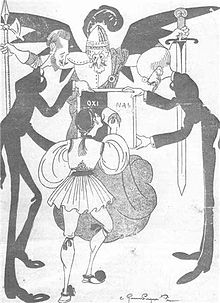Apportionment in the Hellenic Parliament
Apportionment in the Hellenic Parliament refers to those provisions of the Greek electoral law relating to the distribution of Greece's 300 parliamentary seats to the parliamentary constituencies, as well as to the method of seat allocation in Greek legislative elections for the various political parties.
Up to and including the 2019 Greek legislative election, Greece employed a semi-proportional representation system with a 50-seat majority bonus.
The May 2023 election saw the electoral system change to proportional representation, as the majority bonus will cease to be applied since it was abolished in 2016.
Since the June 2023 election, the system has reverted to semi-proportional representation with a sliding scale bonus, after it was passed in parliament in 2020.
[5] The smallest constituencies are single-seat, while the largest, Athens B3, is represented by 18 members of parliament.
Article 51 sets the minimum number of MPs at 200 and the maximum at 300,[7] while Article 53 regulates the way in which constituencies and the electoral law can be changed, while also specifying that up to one twentieth of the total number of MPs (5%, or between 10 and 15 depending on the size of the parliament) may be elected on a national level instead of in constituencies.
Proportional representation (PR) was first introduced in Greece in the 1926 election, replacing the older approval voting system in use since 1864.
[9] The introduction of PR created unstable governments and it has been re-established a number of times since, most recently in 1989, before being abolished.
[10] Reinforced proportional representation favouring the largest party, the type of electoral system used now,[4] was first used in 1951.
[10] The majority bonus was introduced in 2004 to replace the older method of reinforcing the proportional system.
[11][12] In its explanatory report regarding the law, the Hellenic Parliament committee responsible for that piece of legislation concluded that reinforcing the proportional system through a simple majority bonus would significantly lower the malapportionment factor of Greek elections, since it would ensure that all seats are awarded completely proportionally with the exception of the winning party, which would receive a boost equal to 13.33% of the total seats.
[13] In particular, political parties would at a minimum be awarded at least 87% of the seats they would be entitled to if the system was not reinforced, as opposed to 70% under the previous law.
[15] The integer of the division of the population of each constituency by the national quota, disregarding the decimals (marked
If there are seats left empty in the first round of allocations, all 59 constituencies are ranked in descending order of leftover decimals (
The integer of this calculation gives the number of seats that each party is awarded,[18] in proportion to its electoral result.
The national quota is used later in order to 'correct' the results in the constituencies, ensuring that the seats of the majority bonus are left vacant as intended.
This provision was abolished in 2016, along with the majority bonus, and in elections after 2019 the total number of votes received by a party will be multiplied by 300 instead of 250.
These MPs are elected through party-list proportional representation using the largest remainder method, with the whole of Greece acting as a single 15-seat constituency.
[20] If there are any seats left vacant in the first allocation, the political parties are ranked in descending order of leftover decimals (
[21] This formula below is a summary of this calculation process: Nine constituencies of Greece (Cephalonia, Evrytania, Grevena, Kastoria, Kefalonia, Lefkada, Phocis, Samos, and Zakynthos) have only a single MP each.
[22] This means that if a party is very popular in a single-seat constituency but has not received 3% of the vote nationally, it is disqualified.
[4] The apportionment of the MPs proportionally-elected in constituencies is by far the most complex step of all the processes, and involves a number of stages.
[23] The total number of votes cast for each party in the constituency is then divided by the constituency quota, and the integer of that calculation corresponds to the number of seats awarded to that party,[23] so that a sum of 5.6 would award 5 seats.
[25] If there are still constituencies with empty seats, all constituencies with empty seats are ranked in descending order of the unused votes of the political party with the smallest number of valid votes on a national level (that has secured at least 3% of the national vote), and one seat is awarded to that party in those constituencies where it is showing the highest number of unused votes, until that party has reached the number of seats it is entitled to in accordance with the national quota.
[29] The Gallagher index (or Least Squares Index), was developed by Michael Gallagher as a means of measuring the electoral disproportionality or malapportionment between the percentage of votes parties receive in an election versus the percentage of seats allocated to them.
[31] Greece used proportional representation in the legislative elections of June 1989, November 1989, and 1990, which had lower Gallagher Indices of 4.37, 3.94, and 3.97.


